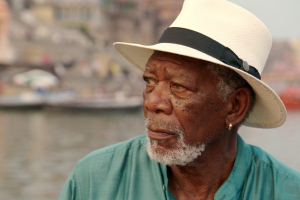Morgan Freeman begins this episode in Mississippi, which he calls his home. He says he lived in many places, including New York, San Francisco, LA, Chicago. "But this place defines me," he says. "You can't understand me without understanding where I was created. Every religion has a creation story, so what do those stories tell us about who we are and where we came from?"
Jewish, Christian and Muslim traditions all trace the beginning of humans back to Adam and Eve. Freeman explains that Genesis tells us of the Garden of Eden- where human life began. There has not yet been a discovery of the spot, said to lie near the Tigris and Euphrates rivers, though many people have tried. Why do people want to find the spot? He says the answer is really interesting, that the Garden of Eden represents the beginning of our communication with God. It could tell us about who we are- like Mississippi life could tell you about Morgan Freeman.
He travels to Jerusalem, and learns about the chapel of Adam- the place that tradition holds is where Adam was buried, and above it, is Golgotha, where Jesus was crucified. According to his expert, the blood of Jesus was said to have flowed down on to Adam, allowing him to be resurrected. They discussed the possibility that the story of Adam and the Garden of Eden could have been a metaphorical story.
He sets out to Turkey to talk with an archeologist about the possibility of the birth of farming, and the birth of believing God are connected. Could this have been Eden? They study the burial practices of the ancient people who lived there. People used to be buried in these "living temples," so that this civilization lived with their dead ancestors!
"Did religion allow man to live together, grow food, or did civilization give rise to our belief in God?" Freeman wants the answer to this, and he goes to the place between the Tigris and Euphrates rivers called Gobekli Tepe where he tries to determine if this might be the first place for the worship of a deity.
"Can science and religion agree on creation?" Freeman travels to his old church in Greenwood, Mississippi, where he reminisces on his past as a boy in church with questions on the beginning of everything, and then explains that as he got older, he discovered the big bang theory and the story of how the earth came to be in the scientific explanation.
He travels to Cairo, Egypt to discover what the Muslim's creation story is. He explains that Islam has deep roots in science, with Muslim astronomers charting the heavens soon after the time of Mohammed. He speaks with Ahmed Ragab, who wrote a book entitled "The Medieval Islamic Hospital: Medicine, Religion, and Charity." Ragab tells Freeman that for Muslims, the beginning starts with a massive cloud of smoke from which the heaven and earth are formed within that cloud before the beings are created. Freeman points out that "it's very cosmic."
Aboriginal people in Australia have passed down stories, and while Freeman isn't involved in this portion, a cultural astronomer is trying to connect the traditional stories to modern science. Their story takes place in an era called "Dreaming" when the "sky gods lived in the Milky Way." They believe that a star baby fell out of a cradle, and down to earth, causing the massive crater at Tnorala. The astronomer noted the similarities between the scientific creation, and the Aboriginal story.
In Rome, Freeman looks at the Judeo-Christian creation story. It's here that he talks to the chancellor of the Pontifical Academy of Sciences which began in 1603 with Galileo. The Catholic church no longer sees the book of Genesis as a literal description of creation.
He interviews another Catholic priest, who is also a scientist at the Academy. He says that Creation is perfectly compatible with The Big Bang Theory and that cosmology allows room for divine creation and offers new ways for a man to understand God as the Master of space and time.
There is a discovery in Mayan ruins that offers perspective on their beliefs in creation at a place called "The Snake Kingdom." Art that was carved in stucco reveals the Mayan creation story. Freeman witnesses a ritual observing the Mayan creation story with the Corn God and the Hero Twins. There is also an idea that Mayans had a trinity of temples(one is no longer standing) that represented the triad of stars in the constellation Orion.
In India, Freeman studies the Hindu religion again, and the main creation story that centers around the Ganges River(Ganga), and the goddess Ganga, who is worshiped for giving life. Hindus do not believe in one creation, but a cycle of creation. The artist ceremony which gives thanks to God every night happens on the bank of the Ganga river.
"All of us, whatever we believe in, can share in one thing- the wonder and gratitude that we are here at all," Freeman says that he hopes that we can see that our beliefs don't have to divide us. "They have the power to unite us, to allow us together to achieve remarkable things."
There are two more episodes left in the series. They will study evil and miracles in the perspective of different religions. Tune in at 9/8c. Find more clips relating to the series in the video gallery. All full episodes, except the first are only available if your local cable provider participates. I foresee these episodes coming to Netflix someday.

























